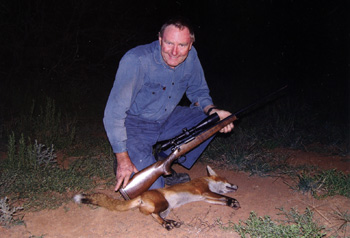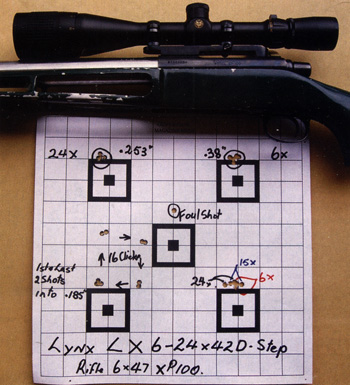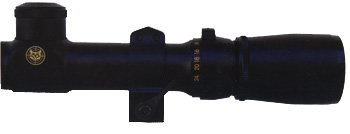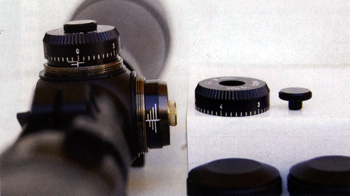
Simplicity in scope reticles for hunting the only way to go, as it gives the hunter less to think about when making that important shot. Why is this important? Because the most important thing to concentrate on in that once in a lifetime hunting scenario is bullet placement and that means trigger control. When you look through a scope and are confronted with multiple dots and circles and other things which divert your attention away from the important things suck as trigger control and bullet placement you are putting a major handicap in your hunting. On game that has to be taken at extended ranges there is usually a little time to think about where you have to hold to effect a clean dispatch.
 |
This fox was no match for the Lynx/ Savage combination, she was about 95 metres away. |
To this end Lynx Engineers have come up with a slight modification to the standard Duplex reticle which unlike dots and circles in the field of view, which have a tendency to cloud your concentration, gives an unobtrusive reference on all four reticle wires which they call MIL – step Reticle. This is achieved by the use of a slightly thicker section. These “steps” of which there are two, are designed to be 100mm at 100 metres (4” at 109.3 yards approx.) on in the case of the 6-24x on 24 power. Because the reticle is in the second focal plane this means that the distance of the step on 6 power is 4 MIL or 400mm at 100 metres. At 12 power it is 2 MIL or 200mm at 100 metres.
This ceases to have much relevance on the lower powers because if you have the scope power down on 6 the range is going to be well inside the distance where you have to think about bullet drop. There is a possibility you may need to remember the difference in extremely high temperatures as the mirage on 24 power and even on 12 power will stop you from having a clear enough look at your target to get even close to telling how big or how far away your target is.
The scope received for review is a Lynx LX 6-24x42D – Step with an adjustable Objective Stature is always an issue with a hunting scope; this scope is as close to perfect in the stature department as it is possible to get given its magnification range. The objective bell measures 53mm OD (Outside diameter) and the ocular lens OD is 38.2mm which means you can mount the scope as low as you like, and that makes for the ultimate combination.
The power ring is fluted which gives a good positive grip with an indexing lug so you know where the power is approximately without looking. This ring is made small enough to ensure it does not obstruct the bolt handle or the back mount base. Add to this a slow focus lockable ocular and perfection is getting closer.
I will have to admit to having some reservations as to the usefulness of a 6 to 24 power scope as a hunting scope, but when combined with a “step” reticle and the explanation in the instructions, I can definitely see possibilities on a rifle which you intend to shoot NON dangerous game. There is a down side to having all this power range and small stature and that is a smaller field of view (FOV). The FOV on 6x is 3.2 degrees, or approximately 5 metres at 100 metres (16 feet at 100 yards). Down to 0.9 degrees or 1.4 metres at 100 metres (4.5 feet at 100 yards) on 24 power. There is 60 minutes in a degree and 1 minute is approx. equal to 1” at 100 yards.
 |
Lynx target shot with a Remington XP 100 in 6x47 loaded with 58 gr V Max. The group on 24 was respectable at 0.253" and it was good to see it better than the group shot on 6 power. It is worth noting the slight difference would not mean much in a hunting situation as you would find the range would be less if you had the scope set on the lowest power. There was a real glitch with the round the target test after the first 16 clicks of movement but as the rest of the test was as close to perfect as I would expect I think the nut behind the butt may be at fault as the first two and last two shots went into 0.185" after 64 clicks of adjustment. The power change test was also acceptable, especially when you consider the fact that the reticle is in the second plane - this result is very good. |
Some other features that Lynx have put in this new model is the new turrets and they are well thought out and are very easy to use. They feature a revolution indicator so you have a good idea of how much adjustment you have used on both windage and elevation. They can also be zeroed correctly. This is achieved by unscrewing the turret locking knob while holding the turret to ensure it doesn’t move when you unlock and lock the locking knob. With the knob removed you simply lift the turret off its splined shaft and zero it and slide it back on the shaft and re-lock the knob. This feature could also be used to re-zero for different loads if you didn’t have to move a turret more than a full revolution. A concise set of notes would be necessary. The click value is 1/8th MOA.
This scope has a slow focus lockable ocular which is the way it should be. I adjusted it when I put it on the green bench gun and it will be fine for many years to come and I can be sure it will always be where I licked it up! Yes I realise with very different eyes to mine may need to adjust it but it is very easy to unlock the lock ring and adjust it but it is very easy to unlock the lock ring and adjust it and lock it again. The adjustable objective is the most correct to scale I have used to date. On the higher powers is very necessary as the field is quite fuzzy if the objective is not adjusted correctly and actually tends to be a little critical. This criticalness can almost be used to obtain a crude ball park range finder.
 |
The business end of the 6 to 24 power lynx that sets it apart from other scopes in the stature department and makes it easy to mount low. Of particular note is the very tactile fluted power ring with its indexing lug so with a little practice you can tell approximately where you are without looking at the scope. The power ring is relatively small in stature so it won't interfere with mounting the scope low. Then we have one of the best features I have seen on a scope for a long time a lockable slow focus ocular so when you adjust it, it stays put! |
Optically this scope is pretty smart, on the lower powers from 6 to about 12 power it is as good as I have looked through. As the power is increased from 12 up it begins to become more critical the further up the power ring is cranked and requires the objective focus to be used to obtain a clear image at any given distance. The image dulls off a little the higher up the power scale you go, this is to be expected over this sort of power range. The hunting usefulness for actually shooting on anything over about 12 power will be very limited as it requires an extremely good rest in a hunting situation to take advantage of all that power and hold it still. I remember many years ago I mounted a 10 power on a rifle I was doing a lot of hunting with thinking I would have it made. It wasn’t long and it was replaced with a straight 6 power. The high power was only of use in a small portion of hunting situations and its smaller field of view was actually a hindrance especially on running game. The Lynx has that scenario covered with power to spare.
 |
The turret setup on the big 6 to 24 power lynx. The things that set these turrets apart from other scopes that I have seen is the reference grid which tells you how much adjustment you have used and the easily removeable turet dials so they can be zeroed, note the locking screw on the right side of the turret scale. |
How did it shoot? About as well as my bench gun and I are capable of. The first 5 shot group on 24 power came in at 0.253” with the next 5 shots on 6 power coming in at 0.38”. At last a better group on the high power. The round the target test had a bit of a glitch after the first 16 clicks of adjustment with the next 6 shots being exactly where they should be. Think the operator must have been a little off. Especially when you look at the first and last two shots creating a 4 shot group of just 0.185” after 64 clicks of adjustment. The 16 clicks should give approximately 2” at 100 yards and it was just short, at 1.93” but in a scope of this design this is a good thing.
The power change test was fairly impressive although I always try for the very best result. A bench rest shooter once told me the less distraction between shots in a group the better your chances are of the ultimate goal of multiple bullets through the one hole. These 6 shots comprising 2 on 24x; 2 on 15x and 2 on 6x with a resultant 6 shot group of 0.76”. For a dedicated hunting scope that is probably as good result I have seen from a scope with the reticle in the second plane. There was obviously a slight shift of 0.3” when you look at the group centres of the two groups shot on the lowest and highest powers.
 |
A rabbit was taken with the big Lynx on the Remington 700 in 250 Savage with 75gr V Max projectiles - the bunny was taken with a head shot at about 120 metres. |
Field shooting consisted of an afternoon at the rabbit patch which is almost completely covered with grass 300 to 400mm tall and Mr Bunny hard to find! I had a friend’s Remington 700 in 250 Savage so I remounted the new Lynx on it in the Redfield bases and Leupold low rings and yes I did try super low rings but the barrel is a custom job and was just a smidgen to allow their use. This old classic was just the ticket for a hunt and bunnies out to 160 metres and a fox in the spotlight at about 125 metres were routinely taken without a hitch.
I tried with the power ring wound all the way up to 2 power but to no avail as the cross is just too fine to see the game in the late afternoon / dusk. On 6 to 10 power it proved to be quite good but as the bunnies were always in the grass it kept me busy on the ones that were always in the grass it kept me busy on the ones that were in the shadows. The rabbits out in the bright sunlight were easy to shoot. The old .250 Savage sure proved it still has the goods with 75 grain bullets at about 3350 fps it was devastating on all but head shots, which it removed cleanly.
I did have a look at a few roos in the spotlight but as the chiller is closed at the moment I didn’t need to shoot any. I liked what I saw although the reticle is just a tad on the small side for spotlight work and I found that once I took the power ring past about 10 power it got too dull to be of much use.
In conclusion if you are in the market for a large range variable to put on a heavier weight varmint / hunting rifle this new Lynx is probably the best value scope in this field I have had the pleasure of using. It is obvious Lynx has done a lot of work on keeping the point of impact close to perfect when the power ring is adjusted and the power ring is extremely clear, especially on lower powers where most of your hunting will be done. Although the reticle is a little on the thin side, for this scope to do what it is intended, it needs to be what it is, just fine.
 |
The adjustable objective on the Lynx. This scope is as close to being parallex free with the scale as I have ever tested. |